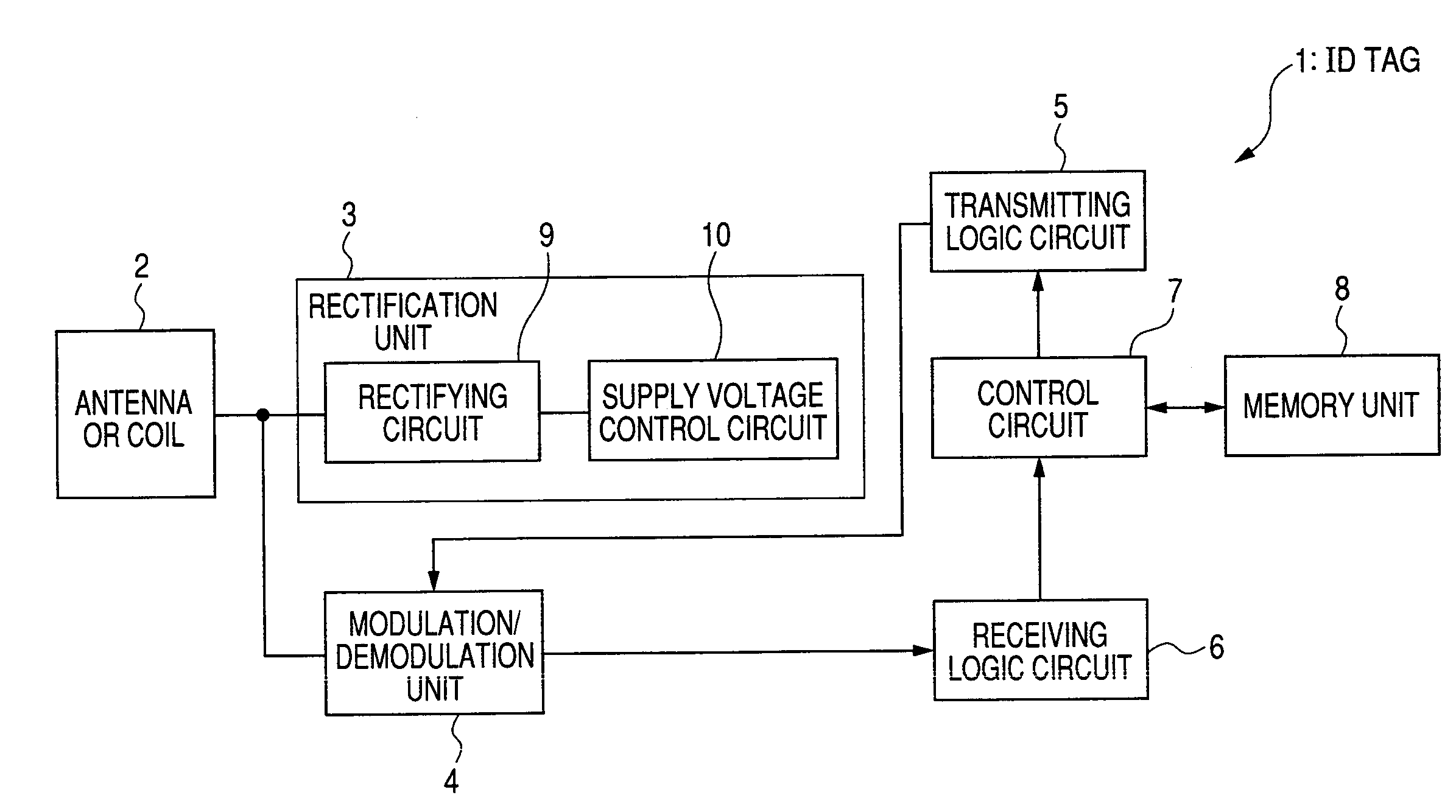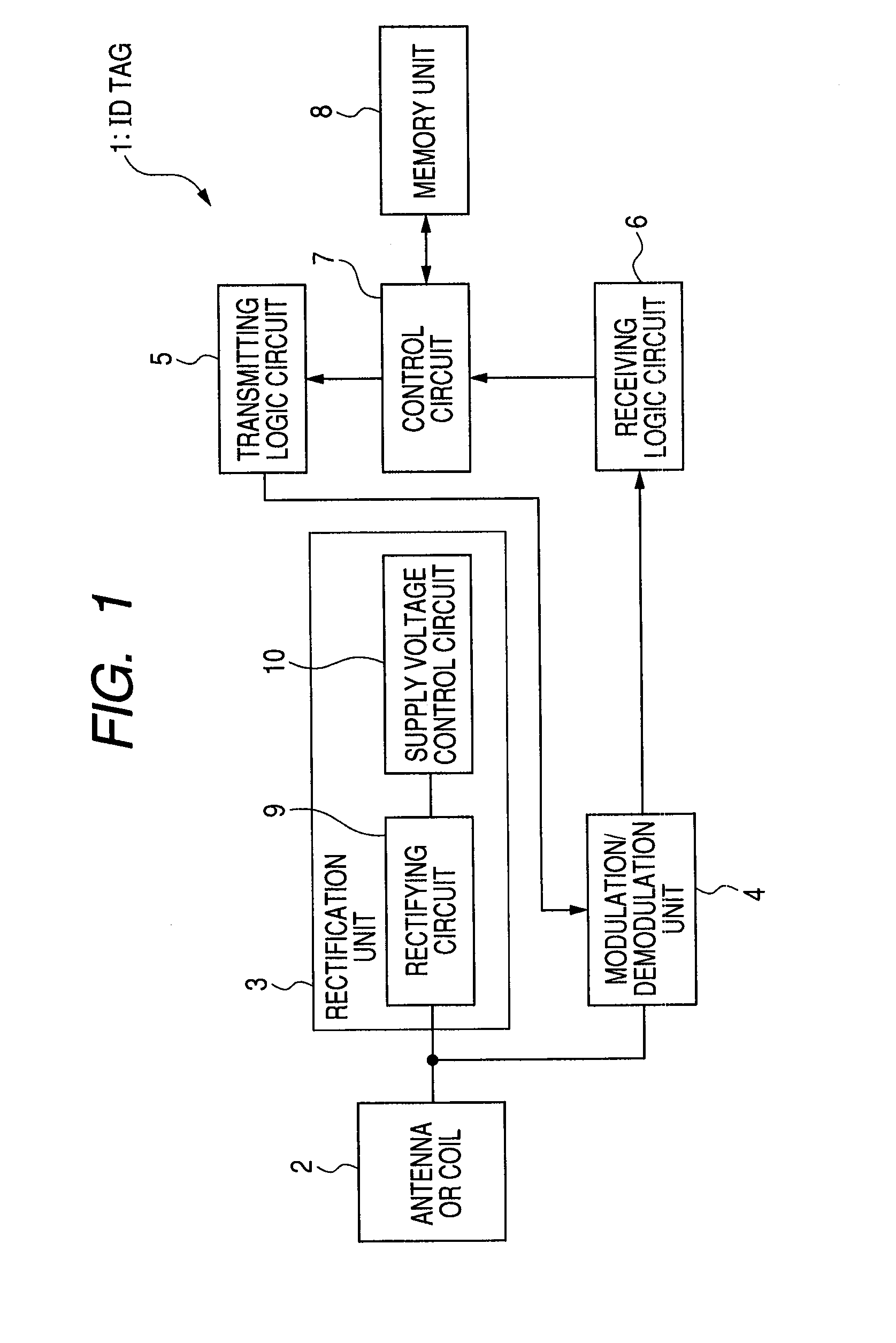Radio frequency indentification tag
a technology of indentification and radio frequency, applied in the field of communication technique of radio frequency identification system, can solve the problems of inability to supply the rectification circuit, power input to the rectification circuit, etc., and achieve the effect of sufficient back scattering strength, improving communication quality, and expanding the range allowing communication
- Summary
- Abstract
- Description
- Claims
- Application Information
AI Technical Summary
Benefits of technology
Problems solved by technology
Method used
Image
Examples
first embodiment
[0046]FIG. 1 is a block diagram showing an ID tag configuration according to a first embodiment of the present invention. FIG. 2 is a diagram illustrating an example of a configuration for a rectification unit and a modulation / demodulation unit in the ID tag of FIG. 1. FIG. 3 is a diagram for a back scattering signal transmitted by the ID tag during back scattering communication.
[0047]In the first embodiment, the ID tag 1 is used for RFID, an automatic identification technique. The ID tag 1, as shown in FIG. 1, is comprised of an antenna 2, a rectification unit 3, a modulation / demodulation unit 4, a transmitting logic circuit 5, a receiving logic circuit 6, a control circuit 7, and a memory unit 8.
[0048]The rectification unit 3 generates an internal supply voltage VDD that is used as the operating power from radio waves received by the antenna 2. The rectification unit 3 supplies the VDD to the modulation / demodulation unit 4, transmitting logic circuit 5, the receiving logic circuit...
second embodiment
[0074]FIG. 4 is a diagram illustrating an example of circuitry including an ASK-modulated signal pre-boost circuit and a switch for back scattering provided in an ID tag according to a second embodiment of the present invention. FIG. 5 is a circuit diagram showing a configuration example for a rectification unit and a modulation / demodulation unit shown in FIG. 4.
[0075]In the second embodiment, the ID tag 1 (FIG. 1) is comprised of an antenna 2, a rectification unit 3, a modulation / demodulation unit 4, a transmitting logic circuit 5, a receiving logic circuit 6, a control circuit 7, and a memory unit 8 in the same way as the foregoing first embodiment.
[0076]The rectification unit 3 is comprised of a rectifying circuit 9, a regulator 10a, and a static capacitor 10b, as is the case for the foregoing first embodiment. The modulation / demodulation unit 4 is comprised of a switch 12 for back scattering (modulator element) and a demodulator comprising an ASK-modulated signal pre-boost circu...
third embodiment
[0093]FIG. 6 is a diagram illustrating a configuration for a rectification unit, a modulation / demodulation unit, a memory unit, a boost circuit for memory, and an internal circuit provided in an ID tag according to a third embodiment of the present invention.
[0094]In the third embodiment, the ID tag 1 comprises an antenna 2, a rectification unit 3, a modulation / demodulation unit 4, a transmitting logic circuit 5, a receiving logic circuit 6, a control circuit 7, and a memory unit 8 in the same configuration as for the above first embodiment, and further includes a boost circuit for memory 8a for supplying power to the memory unit 8.
[0095]FIG. 6 is a diagram illustrating the configuration for the rectification unit 3, modulation / demodulation unit 4, memory unit 8, and boost circuit for memory in the ID tag 1.
[0096]In this case, the switch 12 for back scattering is provided in the boost circuit for memory 8a, which is different from the above first embodiment, instead of being provide...
PUM
 Login to View More
Login to View More Abstract
Description
Claims
Application Information
 Login to View More
Login to View More - R&D
- Intellectual Property
- Life Sciences
- Materials
- Tech Scout
- Unparalleled Data Quality
- Higher Quality Content
- 60% Fewer Hallucinations
Browse by: Latest US Patents, China's latest patents, Technical Efficacy Thesaurus, Application Domain, Technology Topic, Popular Technical Reports.
© 2025 PatSnap. All rights reserved.Legal|Privacy policy|Modern Slavery Act Transparency Statement|Sitemap|About US| Contact US: help@patsnap.com



